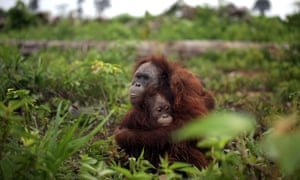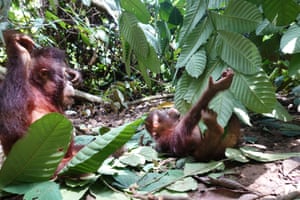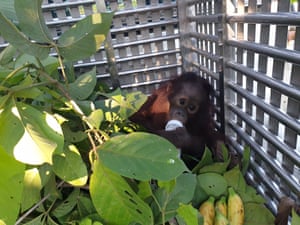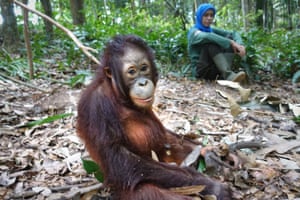They were the lucky ones: Robin, Amalia, Eska; three orphaned orangutans unrelated but by circumstance, rescued from a private zoo in the East Kalimantan province of Indonesian Borneo in early 2017.
A wealthy businessman had amassed an extensive collection of animals – sun bears, gibbons, reptiles, birds of prey – then run into trouble. When staff from the local orangutan rescue centre, Jejak Pulang, arrived on site, the zoo was already being dismantled, with animals boxed up for transit to uncertain fates.
Four-year-old Eska – small enough to sit on someone’s lap – and his fellow apes made the 50km journey to Jejak Pulang’s base in Samboja village, where staff had worked into the night to finish quarantine facilities in time.
Within 12 months of those first arrivals, the organisation received five more orphaned orangutans, bringing the number at its Four Paws Forest School to eight.
Over the past two years, primatologist Dr Signe Preuschoft and her team have been painstakingly teaching these young apes how to survive in the rainforest ahead of their eventual return to the wild.

Orangutans are classified as critically endangered, their decline driven by habitat destruction and increased conflict with humans. Conservationists put the number left in the wild on Borneo at between 70,000 and 100,000.
About 350,000 hectares of primary forest continues to be lost across Indonesia every year. More recently, coronavirus has thrown up a new threat, with concerns that it might affect great apes as well as humans. Two-year-old Damai, a former pet, arrived at the Forest School this month, intercepted before he could be dumped by his owner – it is thought, over fears of Covid-19 transmission.
Against such odds, some may question spending finite energy and resources on just a few individuals. But in giving them the best possible prospects for survival, Preuschoft aims to protect not just these lucky few but their habitat, and the many species that depend on it.

Her hope is that by using the immediate need of the orangutans in her care as leverage, she can secure long-term protection for a precious patch of rainforest for their release. They can then serve as an “umbrella species”, fostering the biodiversity of that ecosystem.
She calls this strategy “restorative conservation”, combining animal welfare with broader conservation goals.
“I worry that I am being overambitious, but I don’t know how to make it work in a less complex way,” says Preuschoft. “If we fiddle a bit here and there, it’s not going to do the job.”
Preuschoft studied psychology in her native Germany before realising that apes interested her more than humans did. She continued her studies in Utrecht and Atlanta, then from 2001 was based in Vienna, helping former lab chimps recover from trauma.
She has lived in East Kalimantan since 2009, overseeing the orangutan rehabilitation initiatives of the international animal welfare organisation Four Paws, which funds Jejak Pulang.
Preuschoft usually returns to Germany to visit family a few times a year, but is otherwise entirely dedicated to her orangutan “children and grandchildren”. “I follow the apes,” she says. Like humans, orangutans have long “childhoods”, remaining reliant on their mothers – even breastfeeding – until they are seven or eight.

When a young ape arrives at Jejak Pulang, the circumstances of their separation, or how long they have spent in captivity, are usually unclear. Gerhana arrived at eight months, close to death from starvation, but already knowing how to drink from a bottle. Kartini, just over a year old, was completely wild, refusing to eat any food that had not been harvested from the forest. “We had to tame her in order to save her life,” says Preuschoft. “Sometimes it is so absurd – you have to teach them things you hope they never have to learn.”
Under supervision in a 100-hectare (247-acre) area of government-protected forest, the orangutans are taught how to forage for food, build nests, navigate the forest canopy, and other survival skills.
Jejak Pulang’s strategy is to “orangutise the humans, not humanise the orangutans”, which means training for the staff in tree climbing (from professional arborists), how to weave nests from twigs and knowledge of forest fruits.
“It takes years before the caretakers accumulate the essential knowledge,” says Preuschoft. This balance – the orangutans must learn from humans, but only the right lessons – can be challenging to strike.
Kartini has recently developed an aversion to eating protein-rich larvae that suggests to Preuschoft a caretaker once betrayed their own disgust: “If your mother is phobic of spiders, you will also not like spiders.”
The four “babies” have also learned to give food simply from being given it themselves, popping morsels (“normally the ones they like less”, Preuschoft observes) straight into their caretakers’ mouths.
They would never learn to do this from an ape mother, she says. “It’s really a friendly gesture, part of the human language that they have adopted.”
But identifying with humans over other apes could prove fatal in the wild. After Kartini was was first tamed to learn, she then had to be made wild again.
As the babies grow, input from their caretakers is minimised to encourage their independence and their progress towards release is measured against benchmarks set by wild apes. Only Robin – the eldest of those founding three, who has spent most of his life in captivity – has been judged unfit for release.
“That doesn’t mean that he can’t learn to be an orangutan, it means that he can never unlearn the things we call ‘humanised’,” says Preuschoft. The risk is too great that he would gravitate back to civilisation. Years ago, Preuschoft was called three times to rescue an orangutan from a logging camp where he had gone to socialise with humans, be fed, and even have coffee. The third time she picked him up, he had a broken jaw.
“It’s a dangerous affinity,” she says. “The similarities that intrigue us, and I’m sure intrigue the orangutans in the same way – that is the very thing that can endanger their lives.”

The threats to their survival can seem overwhelming at times, Preuschoft admits, from the big picture of consumerism and loss of connection to nature to the more immediate dangers, like land clearing for mines and roads, plantations and poaching.
More challenges keep emerging. Last year the government announced its plan to relocate Indonesia’s bureaucratic centre from Jakarta to the relatively wild East Kalimantan – and with it an estimated 1.5 million civil servants.
Now coronavirus has forced additional precautionary measures, such as washing the orangutans’ food, stockpiling cleaning materials and splitting their caregivers into smaller groups – lest they pass the virus on to their vulnerable charges.
Human contact with the orangutans in the forest school has always been strictly limited to their surrogate mothers, because of the risk of transmission between species. But “the younger ones still need loving contact, and comforting when they are scared”, says Preuschoft. A week after his arrival, Damai is already forming a bond with a veterinarian at the quarantine station.
The older apes, Amalia and Eska, are already mostly independent, opting to sleep several nights a week in the forest school and finding their own food. Before the pandemic, Preuschoft had hoped that they would “graduate” early this year to “Forest Academy”, living with some oversight in the protected area where they will eventually be released.
That monitoring would extend until Preuschoft is satisfied that the apes are entirely self-sufficient. “We would like to be sure that by the time they disappear they know what they are doing.”
Preuschoft argues that “soft release” is supported by scientific literature that shows that orangutans develop gradually. “For me, the release is a process, not an event.”

Of the approximately 2,000 apes reintroduced to the wild in Borneo since the mid-1960s, the ultimate fates of most are not known, as tracking them beyond two years of release is difficult and costly.
Some, Preuschoft believes, were still drawn to humans when they were returned to the wild. She sees her measure of success as not simply to return orangutans to the wild, but to “maximise survivors, and maximise their happiness during the process”.
Preuschoft’s focus on the wellbeing of the individual is considered controversial by some working towards the so-called preventive model of conservation, focused on protecting ecosystems that are currently intact.
“The difference is how important individuals are – that’s the concept that we try to amalgamate,” says Preuschoft. “We use individual biography to make people feel what it means that a species is going extinct.”
If rehabilitation and reintroduction have a part to play in protecting entire species, it is generally considered to be very small. The argument most often made in support of it is that extinction is a process that leaves animals orphaned, stranded, or otherwise in need of immediate help; and many see the alternatives – leaving them to die, euthanasia, or lifelong captivity – as unacceptable.
“You must remember, extinction means suffering,” says Preuschoft. “It means maiming, disease, living in fear, dying, seeing your children die.”
But even if there were not the question of what to do with incoming orphans, Preuschoft believes it is too late for to rely on saving the orangutans’ habitat alone.
In 2007 the United Nations Environment Programme’s The Last Stand of the Orangutan report warned that the species had an “extremely high risk of extinction in the wild in the near future”.
Nothing has changed, says Preuschoft. “What that tells us is that preventive measures alone cannot save the species. That is not just a justification – but a job.”
Her sense of commitment to the apes that pass through her care may extend decades, she agrees – even their entire lives. Already Preuschoft foresees the possibility of having to intervene should the capricious Amalia make her a grandmother (“she hasn’t shown a lot of maternal behaviour”).
For now, the challenge is securing a release site. Preuschoft has identified a 25-hectare area about 200km from the forest school, near the border with Central Kalimantan, which she is hoping to get protected. “In the current climate, any hectare that we protect is a benefit,” she says.
It is a “terrible job”, she adds, to “collect individuals and help them on” as the species continues to be driven to extinction. “I’m not deluded. I’m not thinking that I am going to single-handedly stem the flood.” But in delivering competent animals to the wild, she says, “we hand the torch to the conservationists who work to preserve habitat – ‘now it’s your task’.
“The important thing is, we have hope. I’m not superhuman – I also wouldn’t be able to do it if I didn’t have hope.”
o Signe Preuschoft and Four Paws Forest School feature in the final episode of the three-part BBC One nature documentary Primates, due to air on Sunday 17 May
Find more age of extinction coverage here, and follow biodiversity reporters Phoebe Weston and Patrick Greenfield on Twitter for all the latest news and features